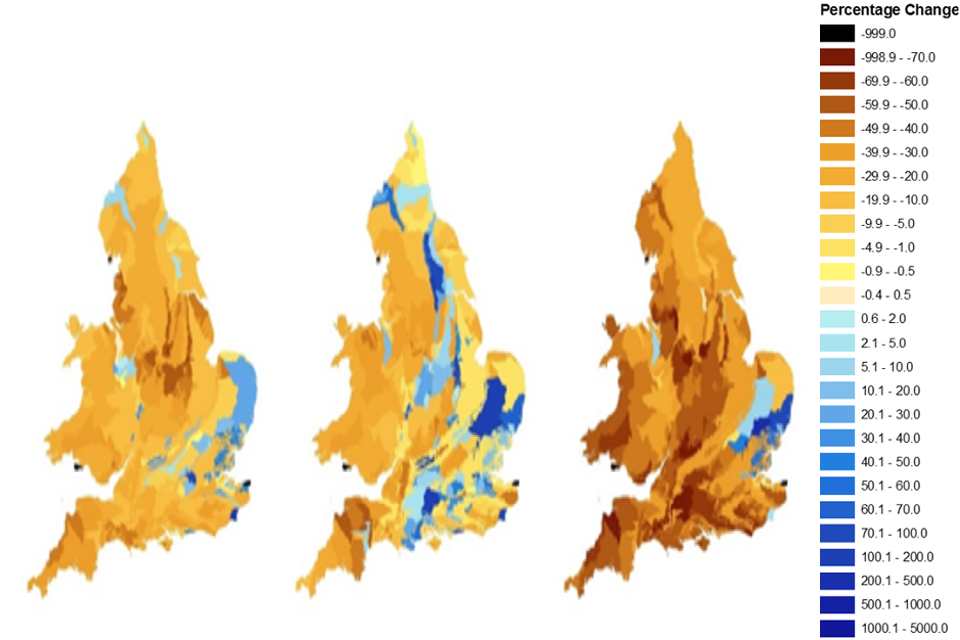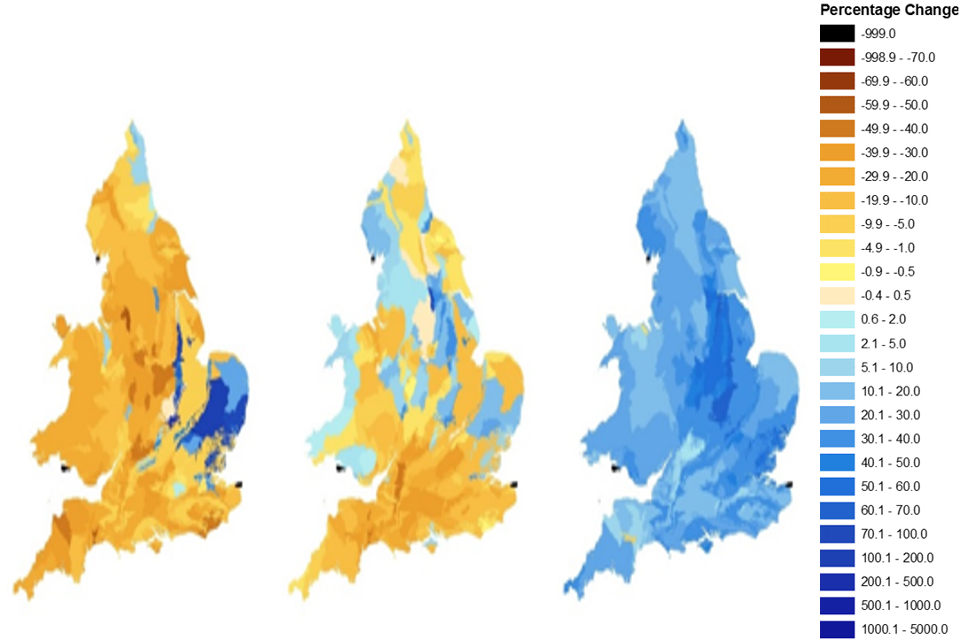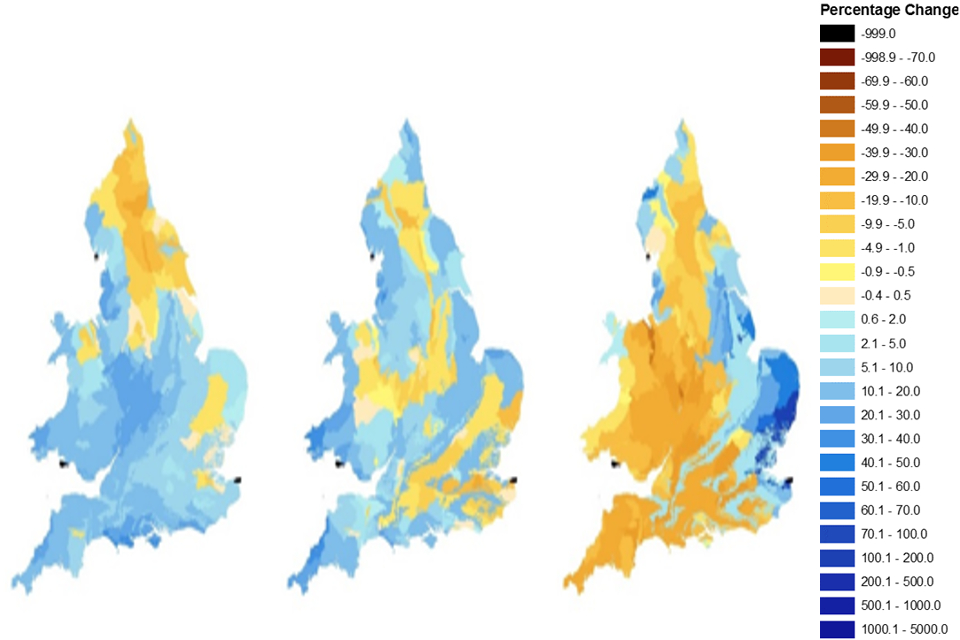National groundwater recharge assessment under climate change - summary
Published 29 August 2019
1. Chief Scientist’s Group research summary
This study investigates replenishment of groundwaters and how climate change might alter this in the future. Around a third of public drinking water supplies come from groundwater and, in parts of the country, this proportion is far higher. Potential recharge is the water that percolates down from the base of the soil zone and has the potential to recharge groundwater aquifers, depending upon the properties of the underlying geology. Groundwater recharge is very difficult to measure directly and is often estimated using models. To determine the amount of groundwater that can be abstracted and used for water supply, it is first necessary to understand how much potential recharge is available to replenish the underlying aquifers.
The study found very little coherence in modelled potential recharge between different climate models during the 2050s. However, by the 2080s there is much more consistency in the recharge signal and there is evidence of a shortening of the recharge season from between 5 and 7 months to 3 to 4 months in future. The total volumes of annual potential recharge remain broadly the same between historic and future scenarios.
Understanding these changes will help people involved in the management of water resources develop management options to ensure the resilience of future water supplies.
1.1 What was done?
To assess how potential recharge may change over the course of the 21st century, a recharge model was run with gridded daily rainfall and potential evaporation data from the Hadley Centre regional climate models. The climate data consisted of 11 possible futures (ensemble members) based on a medium emissions scenario. This data was originally produced as part of the Future Flows and Groundwater Levels project.
The recharge model ZOODRM calculates potential recharge using a modification of the UN Food and Agriculture Organisation method. It calculates recharge using an energy-balance method to estimate actual evaporation, with the remaining rainfall being potential recharge. The output consists of daily potential recharge values aggregated on a monthly basis from 1951 to 2099 for mainland Britain on a 2 km2 grid. The values were summarised for 208 groundwater bodies and for the river basin districts for England and Wales. The monthly changes in potential recharge were then summarised for the 2020s (2010 to 2039), 2050s (2040 to 2069) and the 2080s (2070 to 2099).
1.2 What did the work show?
The 2020s and 2050s show a mixed picture with some areas showing an increase in potential recharge that becomes clearer the further into the future the estimations are made.
Towards the end of the 21st century (2080s), the results suggest that potential recharge will be concentrated in fewer months and potential recharge in summers will be lower. If the amounts of potential recharge are less in summer this means that the recharge season is delayed as the soil has to be wetted up.
The percentage change in monthly recharge (mmd-1) compared to historic simulations (1951 to 2009) was calculated for each of the 11 ensemble members for each groundwater body in England and Wales. The maps below of the 2080s show that the median monthly potential recharge of the ensembles decreases in September and October as a result of the generally hotter, dryer summers which delay the start of the recharge season (due to greater soil moisture deficit). Potential recharge is consistently greater from November through to February, becoming more spatially variable in spring, with a clear east-west split evident in May.
The historical recharge season from September to April therefore appears condensed into a shorter window, as recharge occurs in fewer months.
The volumes of annual average potential recharge for the river basin districts indicate that the total potential recharge will either stay the same or increase. From this, it can be concluded that the recharge season will consolidate into fewer months.
There is an east–west split, with western areas showing more pronounced winter gains and summer losses in potential recharge as well as greater variability between ensemble estimations in the future than in eastern areas.
This is due to the nature of British weather systems, in particular the distribution of rainfall, and how this may vary in the future.
The work has a number of limitations, as it does not consider:
- the range or distribution of arable crops grown in the UK (the model uses maize as the reference crop for arable areas)
- changes to the growing season (the model uses a fixed and constant growing season),
- soil health (how famers look after their soil)
- rainfall intensity (how stormy the rain may become)
- any modification of recharge resulting from the unsaturated zone and other, minor aquifers which may lie above the water table (i.e. actual recharge)
Further work is also required to understand how droughts could affect potential recharge in the future.
1.3 What do the results mean for managing water resources?
The net future annual recharge volumes are broadly stable, suggesting that groundwater water resources are maintained from an overall water balance perspective.

Median percentage change in potential recharge for groundwater bodies in England and Wales (mm/day) (brown decrease and blue increase) Summer (June, July August) 2080s

Median percentage change in potential recharge for groundwater bodies in England and Wales (mm/day)(brown decrease and blue increase) Autumn (September, October and November) 2080s

Median percentage change in potential recharge for groundwater bodies in England and Wales (mm/day)(brown decrease and blue increase) Winter (December, January, February) 2080s

Median percentage change in potential recharge for groundwater bodies in England and Wales (mm/day)(brown decrease and blue increase) Spring (March, April and May) 2080s
However, the future recharge season appears to be condensed into a shorter period. This could lead to more variable groundwater levels and greater drought vulnerability. The latter might be the case if rainfall ‘fails’ for one month, since rainfall totals are reliant on fewer months. The lead-in time for reaching drought status could also be reduced if the recharge window decreased.
1.4 Publishing details
This summary relates to information from project SC160018, reported in detail in the following output:
Report:
SC160018/R, BGS No: OR/17/026
Title:
National-scale recharge assessment under conditions of climate change
The report is available to download from http://nora.nerc.ac.uk/id/eprint/521605
August 2019
Project manager:
Natalie Phillips, Research, Analysis and Evaluation
Research collaborators:
Andrew Hughes and Majdi Mansour, British Geological Survey, Keyworth, Nottinghamshire NG12 5GG
This project was co-funded by the Environment Agency and the British Geological Survey.
Enquiries:
research@environment-agency.gov.uk
© Environment Agency

